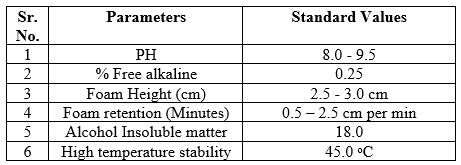Medicinal herbal soaps contain antibacterial and antifungal substances extracted from plant parts such as leaves, roots, stems, and fruits, and are primarily intended to treat wounds and illnesses and promote health. Use a mild soap to wash and clean. Aloe vera is a natural product used to prevent and treat various skin problems. Aloe vera stimulates fibroblasts that produce collagen and elastin fibers, increasing skin elasticity and reducing wrinkles. The main objective of our review is to develop and evaluate an anti-aging herbal soap with various functions such as anti-aging, anti-aging, anti-inflammatory, anti-acne and antibacterial. Parameters such as pH, physical evaluation, foam test, foam retention, acid percentage determination, rapid stability test, foam height and insoluble alcohol were investigated. Based on these results, we recommend that the formulation is stable and safe for use on the skin.
Aloe vera, Anti-aging, Anti-bacterial, Herbal soap, Evaluation.
Ayurveda is one of the oldest traditional medicines practiced in India, Sri Lanka and other South Asian countries and has a good philosophical and empirical basis [1]. Atharvaveda, Charaka Samhita [2], and Sushruta Samhita are the major classics that detail over 700 herbs, minerals, and oils for maintaining and promoting healthy and beautiful skin. Acne is one of the most common skin problems among teenagers. and in youth [3]. There are three main types: acne vulgaris, acne vulgaris, and acne rosacea. Acne vulgaris is known as a superficial disease that involves the hair follicles and sebaceous glands of the skin. It also appears as blackheads, whiteheads and inflammatory processes. Various injuries to the face, chest, shoulders, and back are not life-threatening, but they cause physical stress and affect the quality of life [4]. Throughout history, plant products and extracts have been used as herbal medicines. Since the advent of functional foods, medicines, cosmetics and dyes, people have been using them to prevent and treat various diseases. Plants have different medicinal properties and are used for this purpose [5]. Skin infections are mainly caused by fungi, staphylococci and streptococci [6]. Ethnomedicinally, the leaf extract of the plant is mainly used as anti-inflammatory and anti-inflammatory [7]. Herbal soaps are medicines containing antibacterial and antifungal agents obtained from plant parts such as leaves, roots, stems and fruits, mainly for healing wounds and diseases and promoting health [8]. The soap has various properties like good moisturizing effect and long lasting fragrance. Herbal soaps are made by adding different types of dried herbs, flowers and steam to the soap base. Medicinal plants are natural products used in the treatment of almost all skin diseases because of their high medicinal value, accessibility, cost and suitability [9,10]. The properties of the soap include soft skin, rich skin, protection against various skin diseases, treatment of skin infections (such as ringworm), skin tone, smooth skin, etc [11]. Compared to chemical products, pharmaceuticals are cheaper, readily available and have fewer side effects [12]. Soap should contain antibacterial and not damage body tissues. Health care workers should use soap according to hygiene and sanitation standards. Therefore, Most people with impaired immune systems are not susceptible to infection by pathogens or opportunistic infections [13].
ALOE VERA:
Aloe vera is a plant that reaches 100 cm in height and matures within 5-6 years. Aloe vera is derived from the Arabic words "Rida" meaning "transparent bitter substance" and "Bella" meaning "truth". Ever since the ancient Egyptians called it the "immortality" plant, it has been used for a variety of purposes. In Hindi it is also called "Big Kumari". Aloe vera leaves are used to treat sunburn, burns and skin diseases. Aloe vera soap is used for skin care such as acne, wound healing and sun protection [14]. The scientific name of aloe vera is Aloe barbadensis Miller. It belongs to the Asphoderaceae (Liliaceae) family and is a shrub or tree, perennial, xerophytic, sweet, walnut green. This plant grows mainly in dry areas of Africa, Asia, Europe and America. In India, it is found in the states of Rajasthan, Andhra Pradesh, Gujarat, Maharashtra and Tamil Nadu [15].

Figure 1: Aloe vera plant
Botanical name: Aloe barbadensis miller
Familly: Lilaceae
Chemical constituents: Minerals, salicylic acids, enzymes, vitamins, saponins, sugars, lignin, and amino acids.
Uses of Aloe vera plant [16]:
- It is used to heal skin wounds.
- Soup to treat hair fall.
- Moisturizer
- Aloe vera gel is used to protect the skin from radiation burns.
Moisturizing and anti-aging effects of aloe vera:
Mucopolysaccharides help retain moisture in the skin. Aloe vera stimulates fibroblasts that produce collagen and elastin fibers, increasing skin elasticity and reducing wrinkles. This allows the epidermal cells to adhere to the surface, creating an adhesive effect and softening the skin. Amino acids soften hardened skin cells and zinc helps tighten skin pores. Its moisturizing effects have also been studied in the treatment of dry skin associated with occupational exposure, with aloe vera gel gloves improving skin integrity, reducing fine lines and reducing erythema. It also has anti-acne effects [17,18].
NEEM OIL:
In Vedas, Neem is called "Sarva Roga Nivalini" or "Pansheh". It is widely used to brighten skin color, reduce fine lines, reduce redness, and reduce acne and blackouts. In addition, it is known for its excellent antibacterial properties, including wound healing and skin healing properties [19]. Neem oil has amazing benefits for the skin, which is why skin care experts recommend using skin care products enriched with neem oil for acne-prone skin. [20] Anti-aging – Neem Oil is also anti-aging. Target wrinkles and fine lines caused by dry skin. In addition, the antioxidants in neem oil reduce the production of melanin in the skin and reduce the signs of premature aging. It also helps reduce skin aging and hyperpigmentation [21].

Figure 2: Neem oil
Botanical name: Azadirachta indica A.
Familly: Maliaceae
Chemical constituents:
Azadirachtin, salannin, nimbolinin, nimbidol, nimbidin, nimbin, and quercetin.
Uses:
- Treats Acne. Neem has an anti-inflammatory property which helps reduces acne.
- Nourishes Skin.
- Treats Fungal Infections.
- Useful in Detoxification.
- Increases Immunity
- Insect & Mosquito Repellent
- Prevents Gastrointestinal Diseases
- Treats Wounds.
HONEY:
It makes sense to use honey to prevent aging and wrinkles. This sweet golden liquid has unique properties that nourish, protect and moisturize aging skin. Learn the beauty benefits of honey for resistance and how to use it in your daily life. Honey has many anti-aging properties. In addition to vitamins and minerals, honey is rich in antioxidants that protect your skin from free radical damage, as well as enzyme activity that makes your skin healthy. With its moisturizing properties that exfoliate and reduce wrinkles, honey can be an anti-aging solution for all skin types [22].

Figure 3: Honey
Familly: Apidae
Chemical constituents:
Sugars, minerals, proteins, pigments, organic acids, and many other elements.
Uses:
Used in the treatment of eye diseases, throat infections, bronchial asthma, tuberculosis, thirst, hiccups, hepatitis, dizziness, constipation, fatigue, worm infestation, eczema, piles, healing of ulcers, and wounds and used as a nutritious supplement.
TURMERIC:
Curcumin, a yellow polyphenolic compound extracted from Curcuma longa species, has several therapeutic effects, including antioxidant, immunomodulatory, anti-inflammatory, antibacterial, cardioprotective, nephroprotective, and hepatoprotective effects. It is widely used in traditional Ayurvedic medicine to prevent and control diseases. Protection, anti-inflammatory, anti-rheumatic effects. In recent years, research on curcumin has focused on its use in aging and age-related diseases. Aging is a physiological process in which cellular function declines due to internal or external stimuli. Oxidative stress is one of the most important causes of aging and age-related diseases [23].

Figure 4: Turmeric
Botanical name: Curcuma longa
Familly: Zingiberaceae
Chemical constituents:
Curcumin and two related compounds demethoxy curcumin (DMC) and bis demethoxy curcumin (BDMC).
Uses: Arthritis, digestive disorders, respiratory infections, allergies, liver disease, depression, and many others.
SHIKAKAI:
Shikakai, commonly known by its scientific name Acacia concina, is a climbing shrub with dark brown, pinnate leaves and pink flowers. It is mainly found in the tropical forests of the Indian subcontinent [24]. Shikakai is rich in vitamins and antioxidants that moisturize and nourish the skin. It also helps restore your skin's natural balance of oil and moisture and prevents dryness and cracking. Shikakai powder protects the skin from free radical damage and premature aging [25].

Figure 5: Shikakai
Botanical name:
Acacia concinna
Familly:
Leguminosae
Chemical constituents:
Lupeol, acacic acid, lactone, spinasterol, and the natural sugars glucose, arabinose and rhamnose.
Uses:
Vitamins, minerals, and antioxidants
MATERIAL AND METHODS:
Selection of Herb:
The plant used in the formula is aloe vera. Aloe vera was selected based on the literature.
Procedure:
Pour the required amount of Bees wax into a glass and use a water bath to heat the bees wax to adjust and maintain the temperature. The wax then turns into a liquid form. Then add neem oil, aloe vera, honey and turmeric. Bring the mixture to a boil using a water bath to get a proper mixture without stirring. Then add rose oil to make it fragrance. In the next step, pour this mixture into a soap mold and let the soap cool at room temperature for 2-3 hours. After 2-3 hours, the soap finally forms [26].

Figure 6: Formulation ingredients

Table 1: Formulation materials [26]
To obtain aloe vera extract, the holy jelly is extracted from the center of the aloe vera plant leaf (parenchyma), the aloe vera leaf is harvested, washed with water and a weak chlorine solution, and finally cut into strips. The thick outer skin is removed using a vegetable peeler, and the inner jelly-like pulp in the middle of the leaf is removed, crushed, and mixed with a blender [27].
Extract of neem in oil:
80 g of chopped leaves were soaked in 800 ml of palm oil and heated at 120°C for 3 hours. After cooling to room temperature, the mixture was filtered through filter paper to remove the leaf residue. Flag filters are retained for further testing [28].
EVALUATION TESTS:
The evolution of aloe vera herbal soap includes physical parameters, pH, stability, foam height, foam retention, percentage of non-alcoholic and non-alcoholic solvents.
- Organoleptic evaluation:
- Color: Yellow
- Odour: Aromatic
- Physical evaluation test:
PH:
pH is measured with paper. The pH is 8.0 to 9.5, which corresponds to nature and the pH chart of our skin: pH scale [29].
Foam Retention:
25 ml of 1% soap solution is placed in a 100 ml cylinder. The cylinder was capped by hand and shaken 10 times. Foam volume was recorded at intervals of 1 minute for 4 minutes [29].
Foam height:
0.5 g of this soap sample is dissolved in 25 ml of distilled water. Then 100 ml is transferred to a graduated cylinder and water is added until the volume reaches 50 ml. 25 strokes are given, the volume of water is 50 ml, and the height of the floor is increased by the volume of water [30].
RESULTS AND CONCLUSION:
The pH of the soap is 8.0-9.5 with a pH tape. Other parameters such as foam height, foam retention, free acid and alcohol insoluble matter were also determined.
In this review article describes aloe vera herbal soap formulation to treat various skin problems and improve human health. The formulated soap showed significant antibacterial activity as a commercial standard and all other parameters were good, the herbal soap produced should be standard and a promising alternative to chemical skin whitening soaps in the market. it can be concluded that it can be used as a product. This aloe vera soap is often used for skin irritation, acne, sunscreen, face wash and moisturizer.


 Abhishek Y. Desale *
Abhishek Y. Desale *
 Prerna Shirode
Prerna Shirode
 Mayur Nikam
Mayur Nikam








 10.5281/zenodo.11104054
10.5281/zenodo.11104054